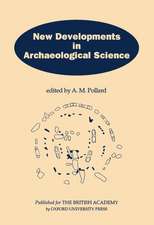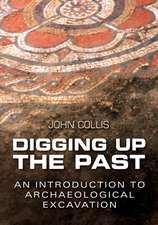Understanding Pottery Function: Manuals in Archaeological Method, Theory and Technique
Autor James M. Skiboen Limba Engleză Paperback – 23 oct 2013
| Toate formatele și edițiile | Preț | Express |
|---|---|---|
| Paperback (1) | 415.95 lei 43-57 zile | |
| Springer – 23 oct 2013 | 415.95 lei 43-57 zile | |
| Hardback (1) | 387.75 lei 43-57 zile | |
| Springer – 15 aug 2012 | 387.75 lei 43-57 zile |
Preț: 415.95 lei
Nou
Puncte Express: 624
Preț estimativ în valută:
79.62€ • 86.51$ • 66.92£
79.62€ • 86.51$ • 66.92£
Carte tipărită la comandă
Livrare economică 21 aprilie-05 mai
Preluare comenzi: 021 569.72.76
Specificații
ISBN-13: 9781461496113
ISBN-10: 146149611X
Pagini: 204
Ilustrații: IX, 192 p. 61 illus., 9 illus. in color.
Dimensiuni: 155 x 235 x 11 mm
Greutate: 0.29 kg
Ediția:2013
Editura: Springer
Colecția Springer
Seria Manuals in Archaeological Method, Theory and Technique
Locul publicării:New York, NY, United States
ISBN-10: 146149611X
Pagini: 204
Ilustrații: IX, 192 p. 61 illus., 9 illus. in color.
Dimensiuni: 155 x 235 x 11 mm
Greutate: 0.29 kg
Ediția:2013
Editura: Springer
Colecția Springer
Seria Manuals in Archaeological Method, Theory and Technique
Locul publicării:New York, NY, United States
Public țintă
GraduateCuprins
1. Understanding Pottery Function.- 2. Intended Function: Inferring Manufacturing Performance.- 3. Sooting and Carbonization.- 4. Attrition.- 5. Residue.
Recenzii
From the reviews:
“James Skibo’s volume, Understanding Pottery Function, is a well-written and well-researched foray into the complex study of vessel use. … Skibo demonstrates through a number of case studies how fruitful partnerships between archeologists and chemists might be formed … . Case studies, in turn, form an integral part of this book and are one of its most pronounced strengths. … this book is a stand-alone beginners’ guide for determining vessel function … .” (Joshua R. Lieto, North American Archaeologist, Vol. 35 (2), 2014)
“Understanding Pottery Function builds on Skibo’s original 1992 book, Pottery Function. … I have no doubt that on reading this volume archaeologists will find that they look at pottery in a completely different light. It will provide them with a means to answer long-debated and seemingly unanswerable questions and also inspire them to ask new ones. Undoubtedly this volume will become a standard point of reference for pottery specialists. I certainly will return to it time and time again.” (Gareth Perry, Assemblage the Sheffield graduate journal of archaeology, November, 2013)
“James Skibo’s volume, Understanding Pottery Function, is a well-written and well-researched foray into the complex study of vessel use. … Skibo demonstrates through a number of case studies how fruitful partnerships between archeologists and chemists might be formed … . Case studies, in turn, form an integral part of this book and are one of its most pronounced strengths. … this book is a stand-alone beginners’ guide for determining vessel function … .” (Joshua R. Lieto, North American Archaeologist, Vol. 35 (2), 2014)
“Understanding Pottery Function builds on Skibo’s original 1992 book, Pottery Function. … I have no doubt that on reading this volume archaeologists will find that they look at pottery in a completely different light. It will provide them with a means to answer long-debated and seemingly unanswerable questions and also inspire them to ask new ones. Undoubtedly this volume will become a standard point of reference for pottery specialists. I certainly will return to it time and time again.” (Gareth Perry, Assemblage the Sheffield graduate journal of archaeology, November, 2013)
Notă biografică
James M. Skibo is a Distinguished Professor of Anthropology at Illinois State University and the 2012 recipient of the Society for American Archaeology’s Award for Excellence in Ceramic Analysis. Besides his ethnoarchaeological work in the Philippines he has conducted research in the American Southwest and he currently works in the Great Lakes and directs the Grand Island Archaeological Project.
Textul de pe ultima copertă
The 1992 publication of Pottery Function applied ethnoarchaeological data collected among the Kalinga and experiments to set forth the principles for the creation of pottery use-alteration traces (residue, carbonization, and abrasion). Analogous to lithic use-wear analysis, this study developed the method and theory making the connections between pottery use traces and function. At the 20th anniversary of the book, it is time to assess what has been done and learned. One of the concerns of those working in pottery analysis is that they are unsure how to “do” use-alteration analysis on their collection. Another common concern is understanding intended pottery function—the connections between technical choices and function. This book is designed to answer these questions using case studies from the author and many others who are applying use-alteration analysis to infer actual pottery function. The focus of Understanding Pottery Function is on how practicing archaeologists can infer function from their ceramic collection.
Caracteristici
Builds on the research presented in Pottery Function, a 1992 publication by the same author Includes numerous case studies by the author Manual includes numerous illustrations to facilitate pottery analysis Includes supplementary material: sn.pub/extras






















